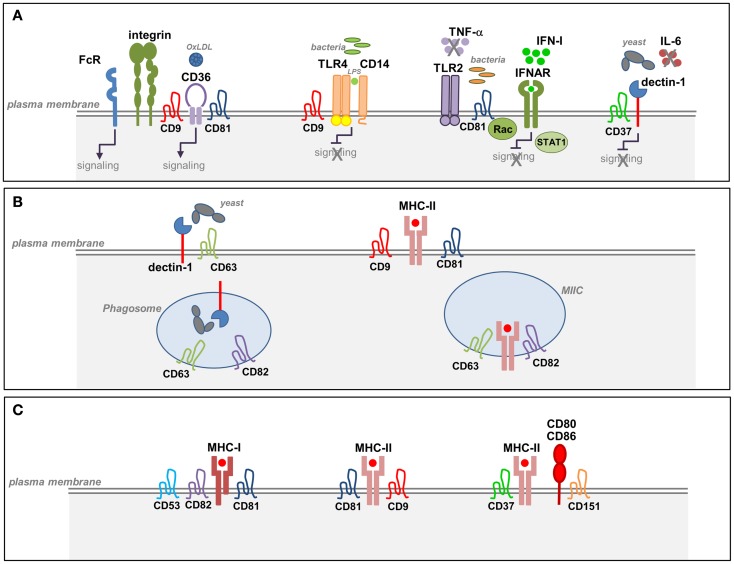Figure 1.
Tetraspanins in the function of APCs. (A) Tetraspanin interactions with pathogen-recognition receptors (PRRs) in APCs. Tetraspanins interact with specific PRRs at the plasma membrane of macrophages and DCs. CD37 associates with dectin-1 and inhibits dectin-1 mediated IL-6 production triggered by the recognition of fungal cell walls. CD9 forms a complex with CD14 and TLR4 and negatively regulates TLR4 signaling in response to LPS. CD81–Rac interaction inhibits TLR2- and IFNAR-signaling pathways and prevents the subsequent activation of STAT1 in response to Listeria monocytogenes. CD36 associates with β1 and β2 integrins and tetraspanins CD9 and CD81 forming a complex that facilitates CD36-signaling and its interaction with FcγRs. Interaction between CD9 and FcγRs promotes phagocytosis and macrophage activation. (B) Tetraspanin interactions during Ag processing and MHC-II biosynthesis. CD63 interacts with dectin-1 in immature DCs and promotes yeast phagocytosis. Both CD63 and CD82 are selectively recruited to yeast-containing phagosomes. CD82 and CD63 are highly enriched in MIIC compartments that contain newly synthesized MHC-II and accessory proteins. (C) Tetraspanin interactions during Ag presentation. Several tetraspanins associate with MHC-I and MHC-II molecules on APCs. Tetraspanins CD9, CD53, CD81, and CD37 associate with MHC-II molecules preferentially at the plasma membrane. MHC-II molecules loaded with a restricted antigenic peptide repertoire are included in TEMs together with accessory molecules and costimulatory molecules. CD9 facilitates MHC-II clustering, and CD151 is involved in the clustering of costimulatory molecules.

